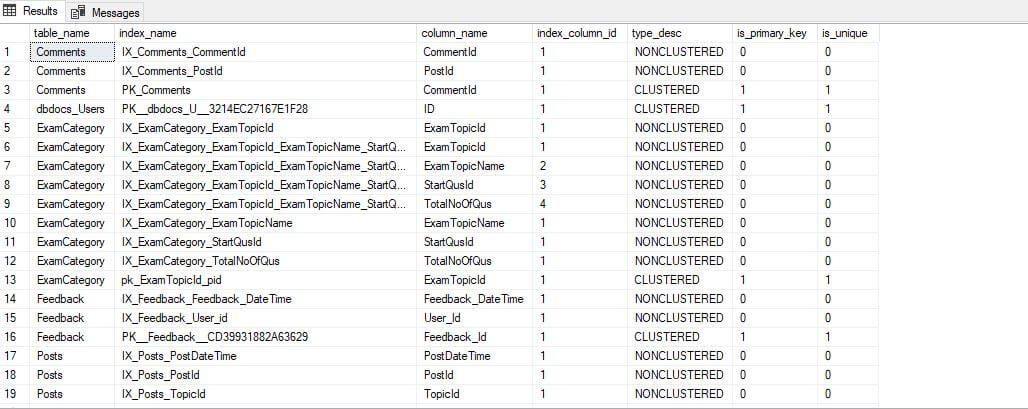List All Indexes In SQL Server
Introduction
List all indexes in sql server with T-SQL
T-SQL description
Conclusion
Introduction
If you've ever wondered how your SQL database organizes and speeds up data retrieval, you're in the right place. Indexes play a crucial role in
improving query performance, and understanding them is key to optimizing your database. In this blog, we'll break down a simple SQL query that
generates a list of indexes within your database, explaining each component along the way.
List all indexes in sql server with T-SQL
This SQL query retrieves information from the
sys.indexes, sys.index_columns, sys.columns and sys.table dynamic management views,
providing a list of indexes in your application database.
use dbdocs; --Replace this with your DBNAME
select
t.name table_name,
i.name index_name,
c.name column_name,
ic.index_column_id,
i.type_desc,
i.is_primary_key,
i.is_unique
from
sys.indexes i
inner join
sys.index_columns ic
on i.object_id = ic.object_id
and i.index_id = ic.index_id
inner join
sys.columns c
on ic.object_id = c.object_id
and ic.column_id = c.column_id
inner join
sys.tables t
on i.object_id = t.object_id
order by
t.name,
i.name,
ic.index_column_id;

T-SQL description
Now, let's break down each component and understand its significance
Column | Description
-------------------------------- | --------------------------------------------
table_name | Table name with the index.
index_name | Index name.
column_name | Column name within the index.
index_column_id | Order of the columns within the index.
type_desc | Index type.
is_primary_key | Generated from a PRIMARY KEY (1=primary key).
is_unique | Index is unique (0=non unique, 1=unique).
By running this query, you'll get a comprehensive list of indexes in your database, including their names, associated tables, columns, types,
and uniqueness constraints. Understanding this information can help you identify areas for optimization and ensure that your database performs
efficiently, especially when dealing with large datasets or complex queries.
Conclusion
In conclusion, indexes are like the table of contents for your SQL database, guiding it to quickly find and retrieve the data you need. With this
SQL query, you can peek behind the scenes and gain valuable insights into how your database is organized, empowering you to make informed
decisions about performance tuning and database design.
Related content